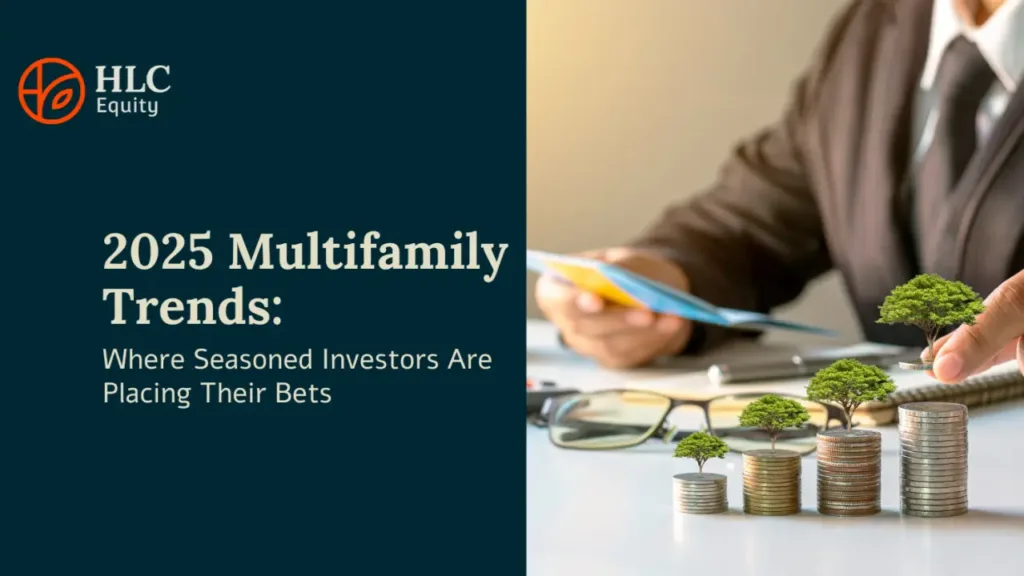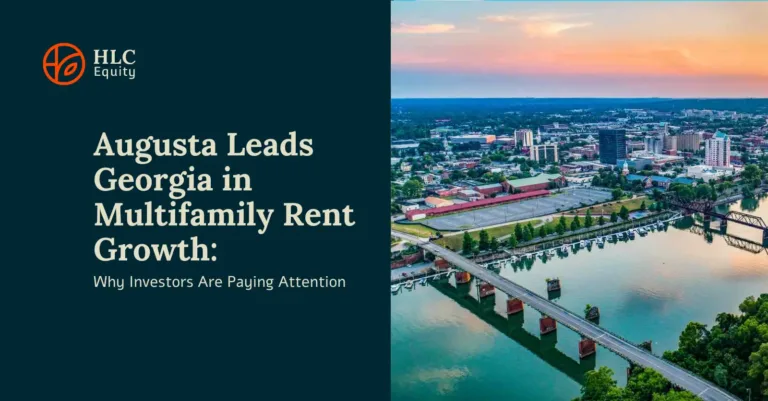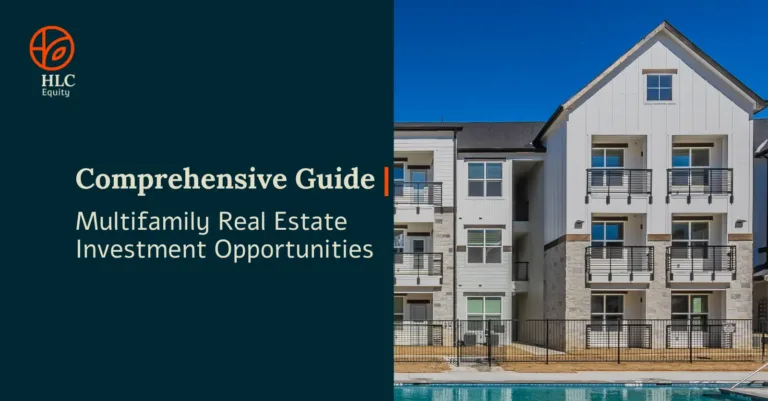
Introduction
The U.S. multifamily real estate market is undergoing profound transformation in 2025. Amid inflationary pressures, fluctuating interest rates, shifting migration patterns, and the continued evolution of renter demographics, experienced investors are fine-tuning their strategies to align with a more complex landscape. While the pace of rent growth is moderating compared to the post-pandemic peak years, the fundamentals underpinning demand remain solid—driven by persistent housing undersupply and evolving renter needs.
As capital becomes more selective and market participants look to balance resilience with long-term returns, informed decision-making is more important than ever. This article offers a focused look at the key trends shaping the multifamily landscape in 2025—from structural supply-demand imbalances and emerging demographic forces to rent growth projections and operational strategies that preserve net operating income.
Drawing from HLC Equity’s 75+ years of experience as a multigenerational owner-operator, alongside recent research from sources like Freddie Mac, RealPage, Arbor, and Callan, we identify where strategic investors are placing their attention today—and how they’re building value in a more measured, but opportunity-rich environment.
Supply-Demand Imbalance Continues to Support Opportunities
Despite years of elevated construction activity, the U.S. housing market remains structurally undersupplied—especially in the multifamily segment. According to Freddie Mac’s 2025 Multifamily Outlook, the U.S. still faces a deficit of millions of units, a gap that continues to widen due to slower new starts and constrained financing availability.
Several factors are contributing to the tightening of new development pipelines:
- High construction costs: Material and labor costs have remained elevated, limiting feasibility for new projects—particularly in urban cores.
- Interest rate pressure: Debt service costs have increased substantially, reducing developer appetite and delaying starts.
- Municipal barriers: Local zoning restrictions and entitlement timelines continue to hinder supply in high-demand markets.
As a result, investors are targeting assets in supply-constrained metros where economic growth, in-migration, and household formation continue to outpace available housing. Sun Belt and Mountain West markets—such as Phoenix, Tampa, Charlotte, and Salt Lake City—are exhibiting particularly strong fundamentals.
This persistent supply-demand mismatch creates a favorable environment for rent stability, occupancy, and long-term appreciation. For experienced investors with a long-term perspective, this offers an opportunity to acquire well-located assets during periods of price recalibration, setting the stage for future upside.
Demographic Shifts Fueling New Demand Patterns
Multifamily housing is no longer a transitional lifestyle for young professionals—it’s become a long-term choice for a wide range of demographics. In 2025, the interplay of generational preferences is significantly influencing demand composition across markets and asset classes.
According to RealPage’s 2025 Demand Drivers Forecast, three key demographic trends are contributing to the strength and diversification of multifamily demand:
- Millennials (ages 30–45) are entering their highest earning years and are still choosing to rent longer due to affordability challenges in homeownership, preference for flexibility, and urban lifestyle amenities.
- Gen Z renters are entering the workforce in large numbers and fueling demand for affordable, community-oriented housing in walkable urban neighborhoods and near employment hubs.
- Baby Boomers are increasingly “renting by choice,” downsizing from single-family homes to Class A or B apartments that offer convenience, services, and simplified living.
These demographic tailwinds are not only expanding the renter pool but also redefining what today’s tenants value—from integrated technology and coworking spaces to wellness-focused amenities and community-building programming.
At HLC Equity, demographic analysis plays a central role in market selection, asset repositioning, and amenity strategy. Recognizing how different renter cohorts behave allows investors to future-proof their assets while ensuring alignment with evolving preferences.
Rent Growth Expected to Moderate but Remain Healthy
After several years of exceptional rent gains in many markets, 2025 is ushering in a period of more sustainable, moderate growth. This is not necessarily a sign of weakness—but rather a rebalancing that reflects the maturing post-COVID recovery and tighter consumer budgets.
According to Arbor’s May 2025 U.S. Multifamily Market Snapshot, national average rent growth has moderated to around 1.7%, though select metros in the Sun Belt continue to outperform due to persistent demand and job creation.
Several supporting factors continue to drive rental resilience:
- Affordability gaps in the for-sale market are keeping more households in rental units for longer periods.
- Limited new supply is creating upward pressure on rents in high-growth metros.
- Increased demand for Class B and Class C units is providing durable cash flow opportunities for investors targeting workforce housing.
Investors are also paying closer attention to renewal rent growth versus new lease growth, as residents increasingly prioritize stability. In-place rents, tenant retention, and lease expiration management are becoming key levers for performance—especially in markets experiencing economic headwinds.
At HLC Equity, strategic focus remains on acquiring assets with proven demand, stable in-place cash flows, and opportunities for light value-add improvements that drive rent premiums without major capital exposure.
Rising Costs and Strategic Adjustments
In today’s environment, operational costs are escalating across the board. From rising insurance premiums and property taxes to increased costs for maintenance and utilities, preserving margins requires tighter financial control and thoughtful repositioning.
Callan’s Multifamily Market Analysis indicates that many cap rates have adjusted upward in 2025, opening the door for yield-focused investors with strong balance sheets to secure acquisitions that meet long-term underwriting thresholds. However, these opportunities require:
- Careful due diligence on operating expenses
- Forecasting cost inflation at the asset level
- Evaluating property tax reassessment risk based on local legislation
Strategically acquiring during a period of market softening can allow investors to capture discounted basis while setting up future value creation through both income growth and cost containment. Long-term capital partners—such as family offices and institutional LPs—are particularly well-positioned to benefit from this countercyclical mindset.
As owner-operators, HLC Equity continuously monitors expense ratios across our portfolio and leverages historical benchmarks and live data to drive performance in both stabilized and transitional assets.
Operational Excellence as a Competitive Edge
In an increasingly margin-sensitive environment, operational discipline and innovation have emerged as key differentiators. Investors are doubling down on initiatives that enhance tenant experience, increase retention, and drive NOI growth without requiring large capital outlays.
Key strategies being implemented across portfolios include:
- Investments in PropTech: From smart locks and package lockers to AI-driven maintenance tracking, operational technology is improving efficiency and transparency for both operators and residents.
- Proactive maintenance and energy management: Preventative strategies reduce costly emergency repairs and improve asset sustainability.
- Resident engagement programs: Community events, mobile communication platforms, and feedback systems enhance satisfaction and reduce churn.
At HLC Equity, operational excellence is embedded into every asset strategy—from leasing velocity and staff training to utility optimization and CapEx planning. These efforts not only improve day-to-day performance but also position assets for stronger valuation when exit windows emerge.
As renters become more discerning and competition intensifies, consistent, high-quality operations serve as both a value proposition and a defensive moat.
Conclusion
The 2025 multifamily market is defined by a complex but compelling mix of persistent supply shortages, nuanced demographic shifts, rent normalization, and cost pressures. For seasoned investors, these conditions represent both a challenge and an opportunity.
The key to long-term success lies in understanding these dynamics in depth—then translating them into asset-level strategies that emphasize discipline, flexibility, and forward-thinking execution. Whether it’s identifying submarkets with resilient demand, optimizing operational performance, or enhancing tenant satisfaction, the path forward requires both experience and adaptability.
With over 75 years as a multigenerational owner-operator, HLC Equity remains committed to navigating this evolving landscape alongside our partners. By focusing on markets that matter, tenants that drive value, and operations that deliver, we continue to pursue real estate investment strategies built for today—and tomorrow.

Sources
- HLC Equity Insights: https://hlcequity.com/category/insights/
- Freddie Mac 2025 Multifamily Outlook: https://mf.freddiemac.com/research/market-trends/20250108-2025-multifamily-outlook
- RealPage 2025 Demand Drivers Forecast: https://www.realpage.com/analytics/2025-demand-drivers-forecast/
- Arbor U.S. Multifamily Market Snapshot May 2025: https://arbor.com/blog/u-s-multifamily-market-snapshot-may-2025/
- Callan Multifamily Market Analysis: https://www.callan.com/blog-archive/multi-family-market/
Important Disclosures: Nothing contained in this blog post constitutes tax, legal, insurance or investment advice, nor does it constitute a solicitation or an offer to buy or sell any security or other financial instrument. Any such offer or solicitation will be made only by means of an offering memorandum and organizational documents (collectively, the “Offering Documents”). This blog and all content on this website are for informational purposes only. We urge investors to consult with licensed legal professionals and investment advisors for any legal, tax, insurance, or investment advice.

